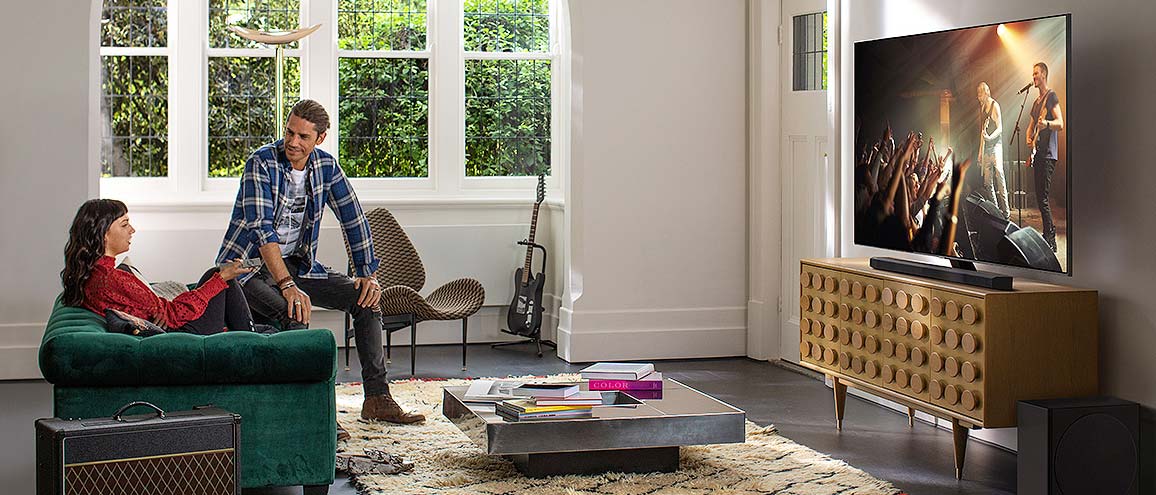Tom's Guide Verdict
The Samsung Q80T TV combines clever smart features, a powerful Quantum processor and impressive Object Tracking Sound to create one of the most formidable Samsung QLED sets yet.
Pros
- +
Rich colors and contrast
- +
Object Tracking Sound works well
- +
Impressive 4K upscaling
- +
Tizen TV is as smart as it gets
Cons
- -
No Dolby Vision support
Why you can trust Tom's Guide
Price: $1,299
Screen size: 55 inches
Resolution: 3840 x 2160
HDR: Quantum HDR 12x
Refresh rate: 120Hz
Ports: 4 HDMI, 2 USB 2.0
Audio: 2 Channel x 60-Watt
Smart TV software: Tizen TV
Size: 48.3 x 27.8 x 2.1 inches
Weight: 39.5 pounds
The Samsung Q80T QLED TV might be the company’s second-tier 4K set, but it passes for something superior. Minus the port array sitting on-unit, the Q80T seems every inch as premium as the top-shelf Samsung Q90T thanks to a full array backlight, local dimming, Object Tracking Sound and a Quantum processor that intelligently upscales low-resolution content.
Better yet, the Q80T costs a couple hundred dollars less than the Q90T and comes in a 85-inch model, making it one of the best Samsung TVs to feed your appetite for a big screen. And while our overall best TV rankings are dominated by OLED sets, this Samsung Q80T QLED TV review explains why it’s a worthy champion for Quantum Dot display technology, and it's still one of the best 4K TVs you can get. Dare I suggest this QLED panel’s blacks are as deep as OLED?
Editor's Note: Since our review ran in February, the price and availability of the Samsung Q80T QLED TV have changed. We have updated the relevant portions of the review, but our overall impressions and recommendations remain unchanged.
Samsung Q80T QLED TV review: Price and configurations
We tested the 55-inch model of the Samsung Q80T QLED TV, which costs $1,299 as of this writing. The smart TV was initially available in five screen sizes, ranging from 50 inches up to 85 inches.
The 50-inch model has since been discontinued, while the 65-inch model has dropped in price to $1,499. If you decide you need a set larger than 65-inches based on our ‘What size TV should you buy?’ guide, you’ll shell out $2,099 for the 75-inch model or $3,799 for the 85-inch model. Of course, you should always check the best TV deals for discounts before buying. Because Samsung has announced a newer lineup of TVs, you could find significant savings on the Q80T.
- 50-inch QN50Q80TAFXZA: Discontinued
- 55-inch QN55Q80TAFXZA: $1,199
- 65-inch QN65Q80TAFXZA: $1,499
- 75-inch QN75Q80TAFXZA: $2,099
- 85-inch QN85Q80TAFXZA: $3,799
Aside from screen size, there aren’t many differences between these sets. The 50-inch model has 40W speakers, while all the larger models have 60W speakers. Sound performance aside, shoppers should expect to see similar performance in the 50-, 65-, 75- and 85-inch makes compared to our 55-inch test sample. All five sizes offer the same display technology, number of HDMI ports and processor.
Samsung Q80T QLED TV review: Design
Unless you consider a single, central stand revolutionary, there’s not much that pops out about the Samsung Q80T QLED TV in terms of design. Like many of the company’s previous QLEDs, the Q80T is outfitted with dark silver metal, straight borders and sharp corners.
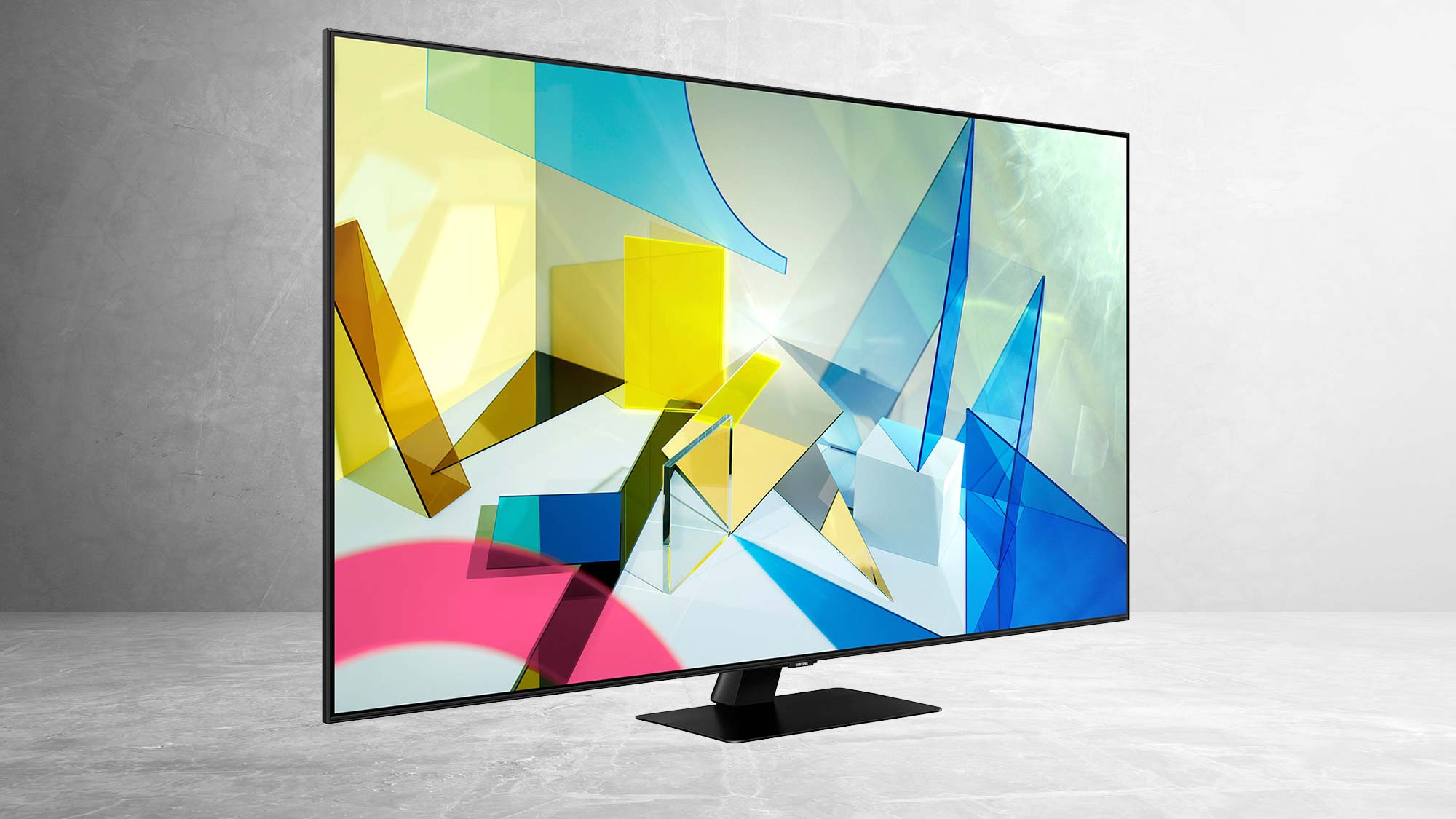
While the stand is sturdy, accommodates any of the best soundbars and helps conceal cables, I’d recommend mounting the TV if only to avoid colliding with one of those pointed edges. You can use a standard 200 x 200-millimeter VESA mount for the 55-inch model, but you’ll need to size up the mount for any larger configurations.
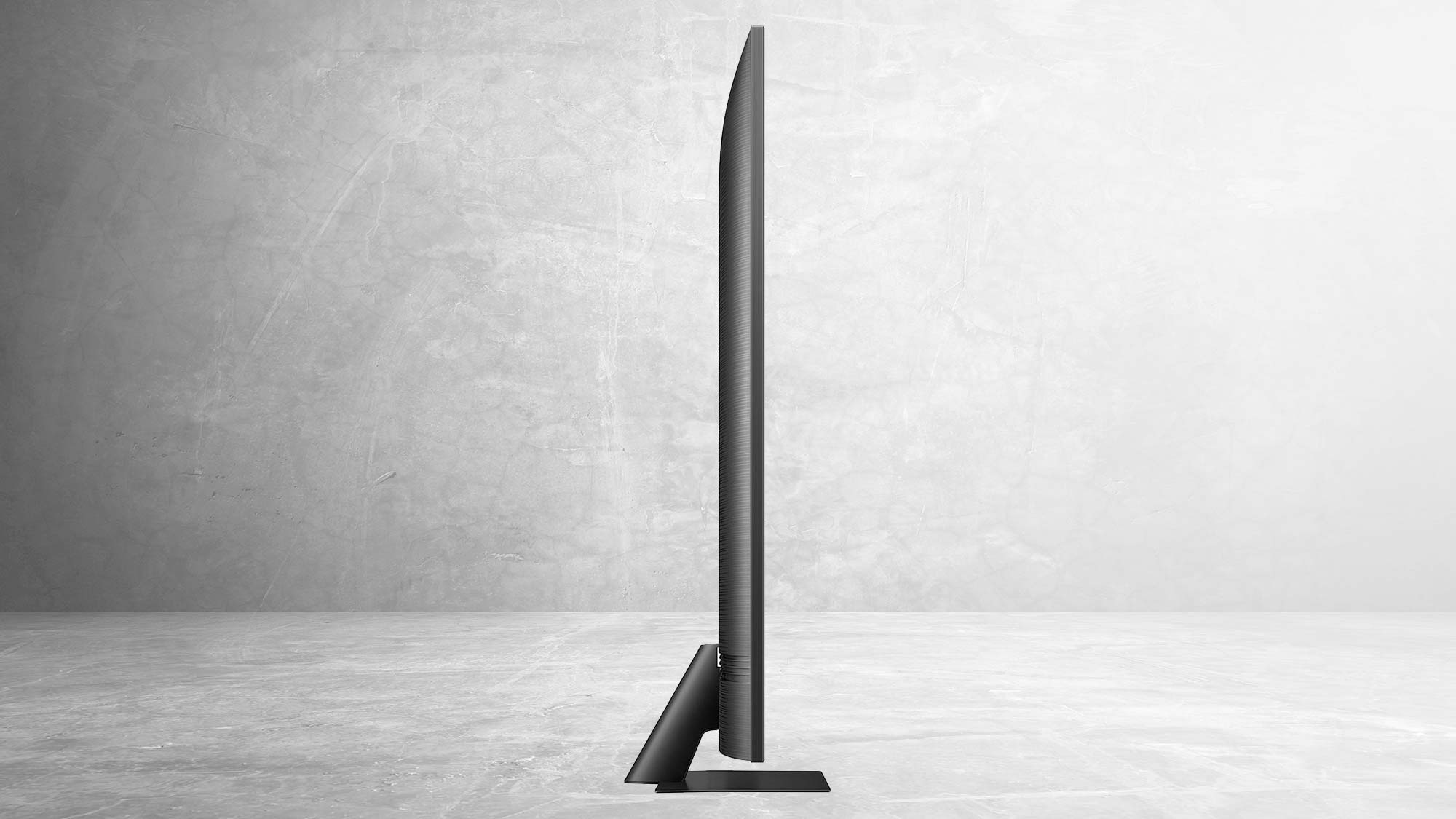
The 48.3 x 27.8 x 2.1 inch body of the set I reviewed seems compact for a 55-inch TVs. The thin bezels lend the appearance of maximum screen real estate, while the rear housing is narrow and mostly uniform — no boxy, protruding compartments like you might find on an OLED.
Samsung Q80T QLED TV review: Ports
Although Samsung allocated similar port arrays to its entire QLED TV lineup, a key difference between the Q80T and Q90T is that this cheaper model lacks the One Connect box. The One Connect box routes all of the Q90T’s connections to a separate unit that can easily be stored out of sight.
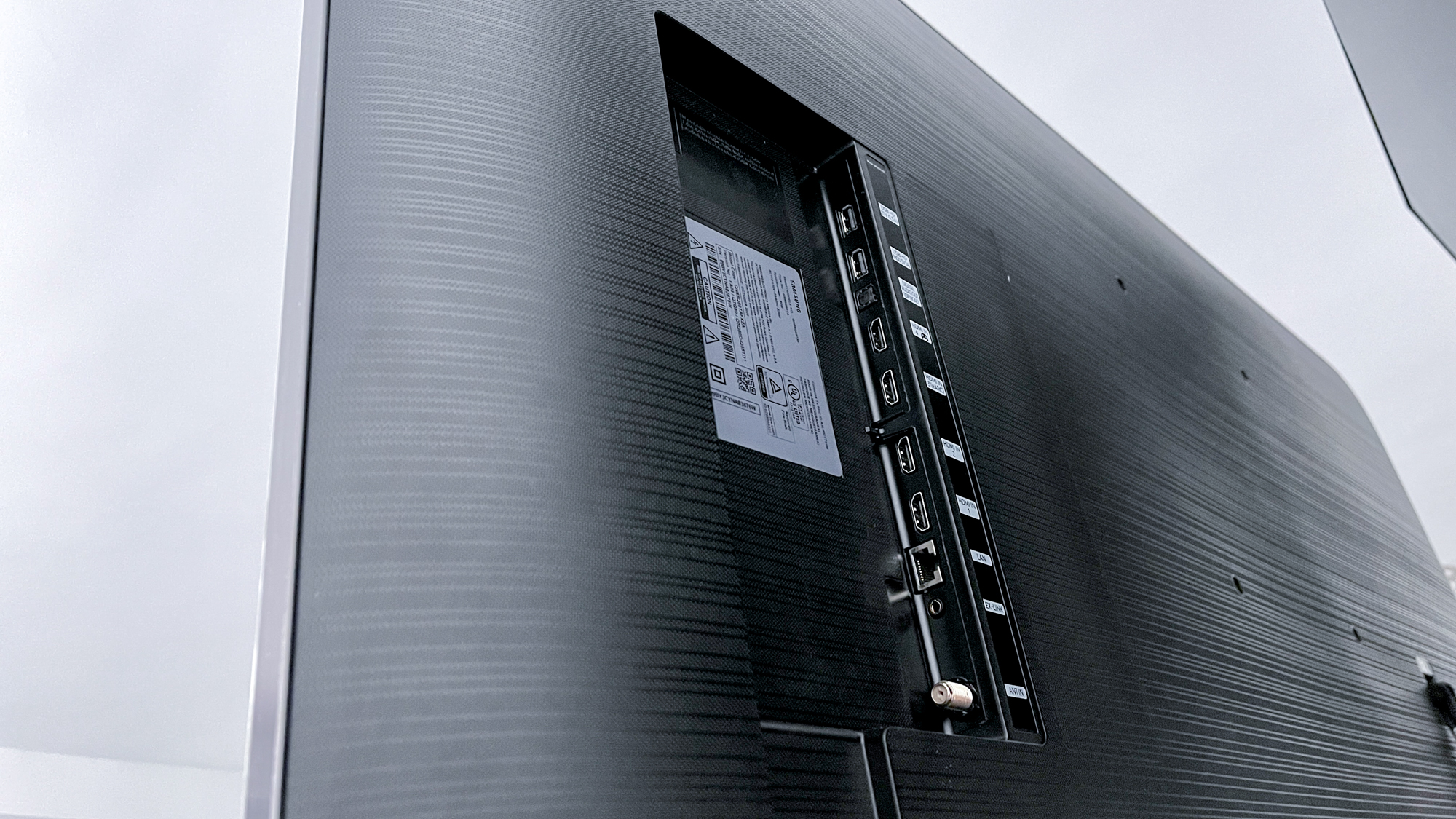
If you plan to hook up multiple entertainment peripherals to your new TV, it might be worth pricing out the Q90T for the One Connect box’s convenience. Otherwise, the Q80T has a more traditional port array found in a concave portion of the set’s backside. You’ll have 2 USB ports and 4 HDMI ports. One of them is rated HDMI 2.1, which supports features like eARC, Auto Low Latency Mode and Variable Refresh Rate.
Samsung Q80T QLED TV review: Performance
With its quantum-dot-enhanced display, full array backlight and an intelligent Quantum processor, the Samsung Q80T promises a superb performance. QLED is usually strong when it comes to robust colors and contrast, and that’s more or less what I experienced during anecdotal testing.
In Spider-Man: Into the Spiderverse, I could see the color complexities and subtle variations between each superhero's suit, even though several wore red or black. Then as Peter B. Parker, Miles Morales and Spider-Woman Gwen Stacey used their web-shooters to swing away from Doctor Octopus’s laboratory, the autumn foliage surrounding them looked artistic as an actual comic book does.
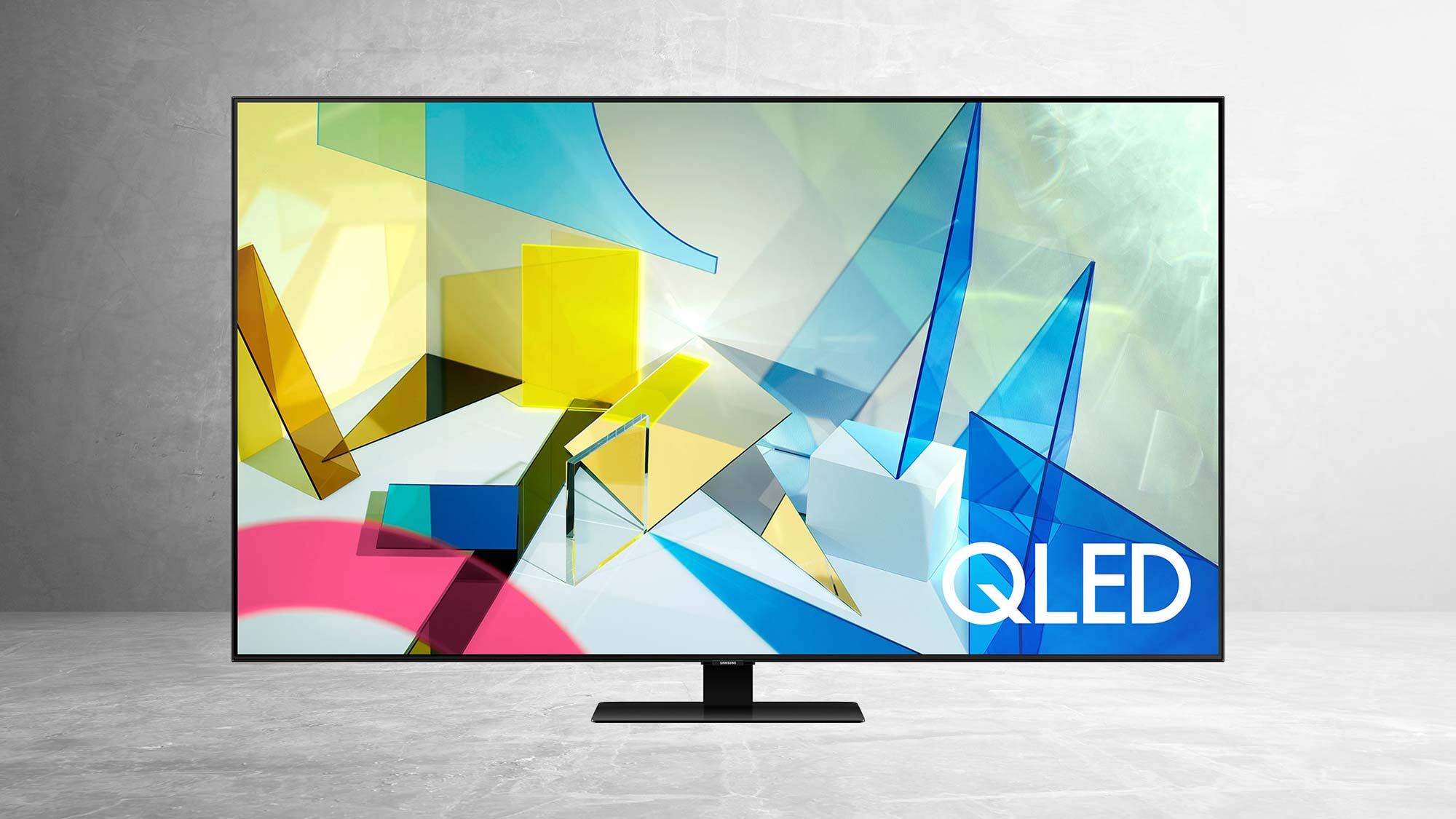
Moving on to one of my favorite scenes for testing contrast capabilities, I turned on Star Wars: Rise of Skywalker. Enter Kylo Ren, cautiously wading through Exegol with his crossguard lightsaber outlined by an eerie halo. Upon discovering the very-much-alive Emperor Palpatine, a strobe effect flashed the screen between dark and intense bright. Many sets struggle with such speedy transitions, especially while maintaining cinematic contrast. I think the Sony A8H Bravia OLED TV does it better, but the Samsung Q80T holds its own with as deep blacks as any LED/LCD set can offer.
Rise of Skywalker similarly gave the Q80T a challenge in motion handling. Just as Rey does to restore balance to the galaxy, the set rose to the occasion. As the aspiring Jedi practically flew through her obstacle course in the Ajan Kloss jungle, the drapery details of her caped getup and curvy, orange details of a tailing BB-8 droid remained crisp.
Of course not all material comes in 4K like the Spider-Man and Star Wars discs we used for testing. Within the Q80T, Samsung’s 4K Quantum upscaler uses AI to enhance image interpolation and insert details you won’t find on regular HD content. I didn’t see any artifacts or graininess when watching the HD discs of the same movies, and I’d even say that the Q80T’s upscaling maintains picture depth more than the Sony OLED.
An added perk of the Samsung Q80T QLED 4K TV is an antireflection layer that makes it a breeze to watch in bright rooms with windows, where I happened to set this TV up for testing. When I reviewed an OLED in this same room, I could only gauge picture performance at night because sunlight compromised the picture brightness too severely.
Samsung Q80T QLED TV review: Test results
The Samsung Q80T QLED 4K TV benefits from very few preset picture modes compared to other sets. Luckily, it has thorough calibration settings. Still, we used ‘Standard’ for most testing, while the tempered brightness and contrast of the Movie mode makes it a favorable viewing option for dark rooms. We also disabled Eco Solution options, which we would use in a normal scenario but impact the TV’s picture during testing. Eco Solution adjusts TV's brightness level automatically based on surrounding ambient light to reduce power consumption.
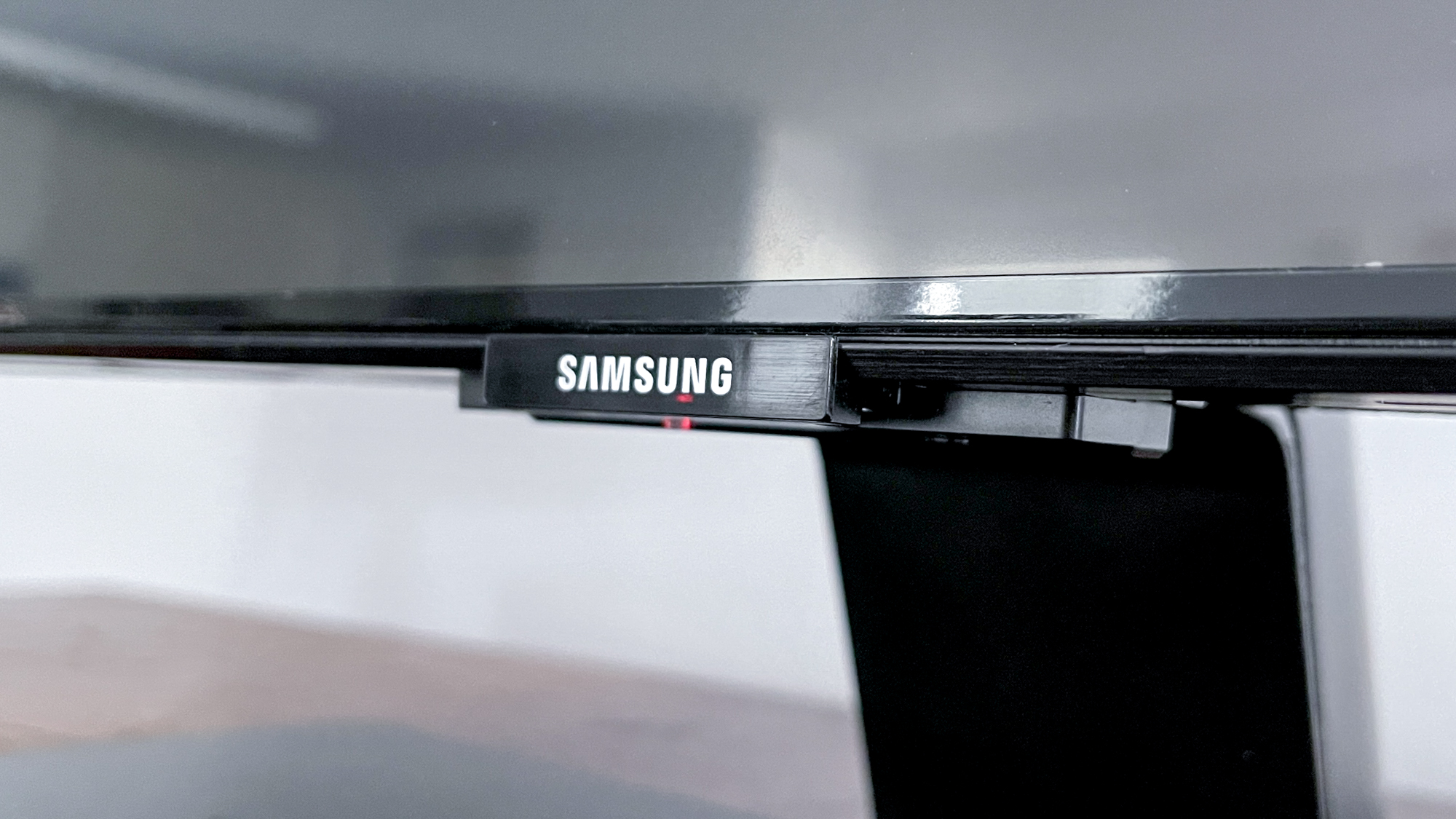
Samsung says the Samsung Q80T has Quantum HDR 1500, meaning the set could reach a peak brightness of 1500 nits. Our Tom’s Guide TV tests registered a maximum brightness of 681 nits, which seems far off from the company’s claims but is a realistic result for comparison. The Samsung Q60T QLED TV, a set two tiers below the Q80T, hit only 418 nits, for example. The Samsung Q70T QLED TV reached just 548 nits, too.
We measure TV accuracy with a Delta-E rating. A smaller score is ideal (0 is perfect), and the Samsung Q80T earned a 3.9, which is poor compared to other sets in the company’s lineup. The Q70T scored a 2.4, Q90 registered a Delta-E rating of 1.5. It also trails behind the LG CX OLED (1.9) and Sony A8H Bravia OLED (1.5).
When it comes to color reproduction, which we measure using a X-Rite i1 Pro spectrophotometer and SpectraCal CalMAN Ultimate calibration software, the Samsung Q80T QLED was able to reproduce 99.93% of the Rec 709 color space. Anything approaching 100% is good for a non-OLED TV, and this QLED scored in range of others like the TCL 6-Series Roku TV (99.96%) and Vizio M-Series Quantum (99.92%).
If you were hoping the Q80T could be a capable accessory for your new Xbox Series X or PS5, you might be disappointed. The TV measured lag time of 30.1 milliseconds. Usually we recommend sets with sets with a lag time below 20 milliseconds for the best gaming TVs.
Samsung Q80T QLED TV review: Audio
The Samsung Q80T QLED 4K TV has 60W speakers, which is powerful compared to 40W ones in the LG CX OLED. Samsung’s set also offers Object Tracking Sound, a technology that’s supposed to tailor the set’s audio to match the content onscreen. So do the built-in upward and downward-firing speakers provide a more immersive soundscape?
As ships zoomed from the left side of the screen towards the right and down towards a planet in The Rise of Skywalker, their hums followed with precision. Then, as Rey and Kylo Ren battled atop the Death Star’s debris on the stormy planet of Kef Bir, the strike of clashing lightsabers stemmed from the source of action while waves crashed on the bottom half of the screen.
Object Tracking Sound nearly makes up for the set’s lack of built-in Dolby Atmos support. That said, it will output Atmos-formatted content for a Dolby Atmos soundbar or speaker.
Samsung Q80T QLED TV review: Tizen OS and smart features
Samsung's Tizen OS platform offers a broad selection of apps, so everyone in your home can stream the content they want. From WandaVision on Disney Plus to any of the best HBO Max shows, you’ll find most (if not all) of the apps you enjoy. Notably, Tizen has a special Apple TV app for enjoying iTunes movies and shows, as well as Apple's original Apple TV Plus shows. No separate Apple TV 4K box needed.
The interface’s Universal Guide also offers content suggestions based on your interests and viewing habits. Otherwise, the home screen’s layout is clean and unobtrusive. You can customize the single row of apps to include all your favorite services, while continuing to watch a show while browsing.
And when you’re not watching TV, you can initiate a screensaver-style, low-power Ambient mode that displays artwork or weather updates. The effect is more impressive on Samsung’s The Frame, but Ambient mode is still a good alternative to the Q80T’s basic black “off” screen.
As a Samsung TV, the Q80T effortlessly meshes with your Samsung SmartThings smart home system. One of the best smart home hubs, SmartThings provides a control dashboard for all of the best smart home devices that are compatible with Samsung’s platform. From the Ecobee (5th gen) smart thermostat to Samsung’s own Family Hub refrigerators, you’re able to use your TV to drop-in or adjust settings quickly.
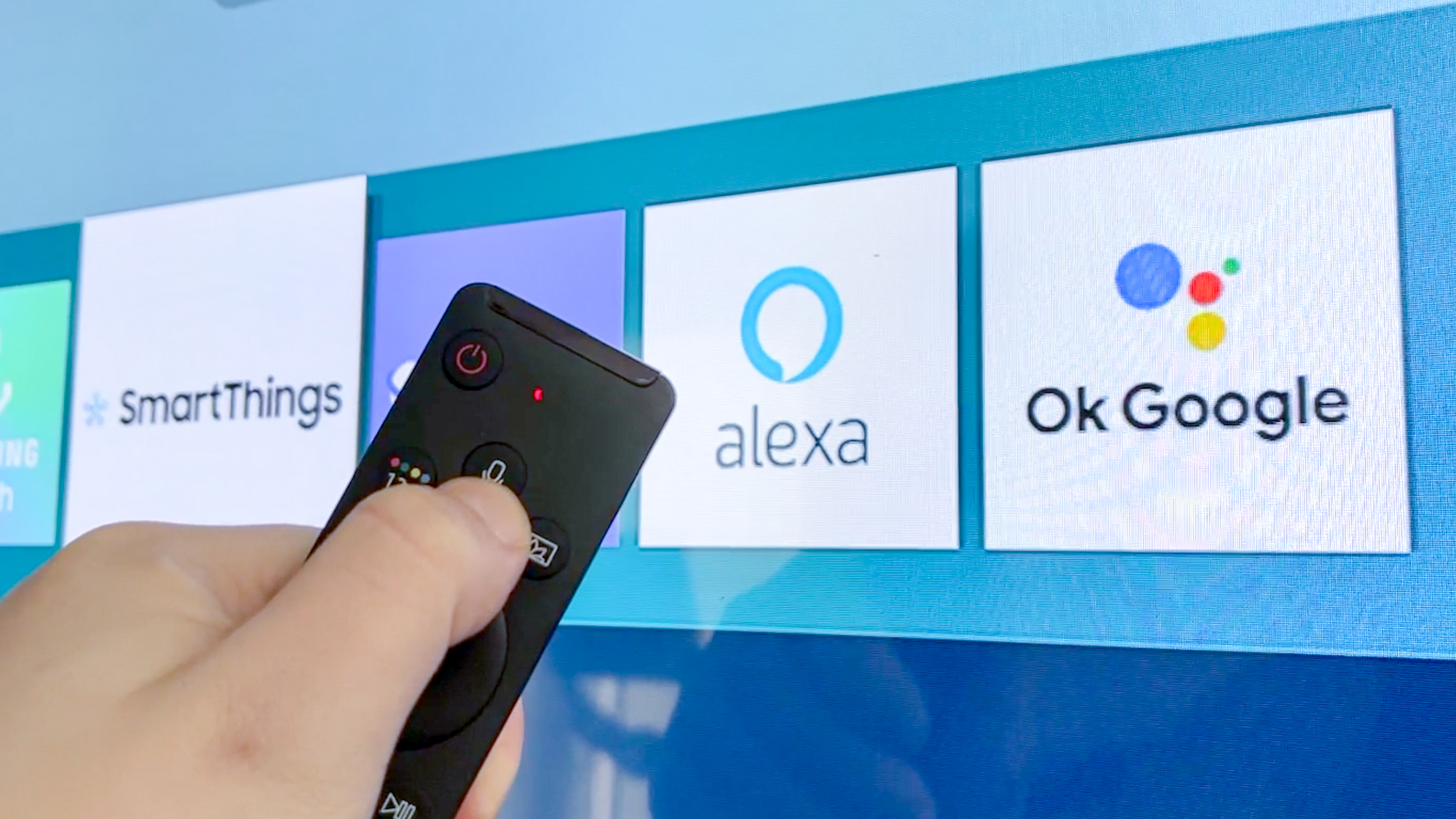
The Q80T similarly offers Samsung's Bixby built-in. Bixby is far from our favorite voice assistant, but it lets you search for content through the remote’s microphone. Since this TV is also one of the best Google Home compatible devices and best Alexa compatible devices, we’d recommend pairing it to Google’s or Amazon’s assistant. While some of Samsung’s other sets require you to pair the set with one of the best smart speakers to actually control the TV via voice, the Q80T lets you use a third-party assistant right from remote. From there, you can integrate the set into your smart home routines and control additional smart home devices without getting up from your couch.
Another smart feature I found myself using often on the Samsung Q80T QLED TV is screen mirroring. I casted home videos and iOS apps from my iPhone via AirPlay 2, although those with Samsung phones like the new Samsung Galaxy S21 or Samsung Galaxy S21 Ultra could use Smart View. You can mirror your Windows 10 PC to the Q80T’s screen, too.
Samsung Q80T QLED TV review: Remote
The Samsung Q80T comes with Samsung’s slender remote, which is comfortable to hold and provides all the expected controls. Alas, I wish it had some kind of built-in lighting beyond the faint microphone status dot so I could find the remote on my black couch when watching TV or movies in the dark.
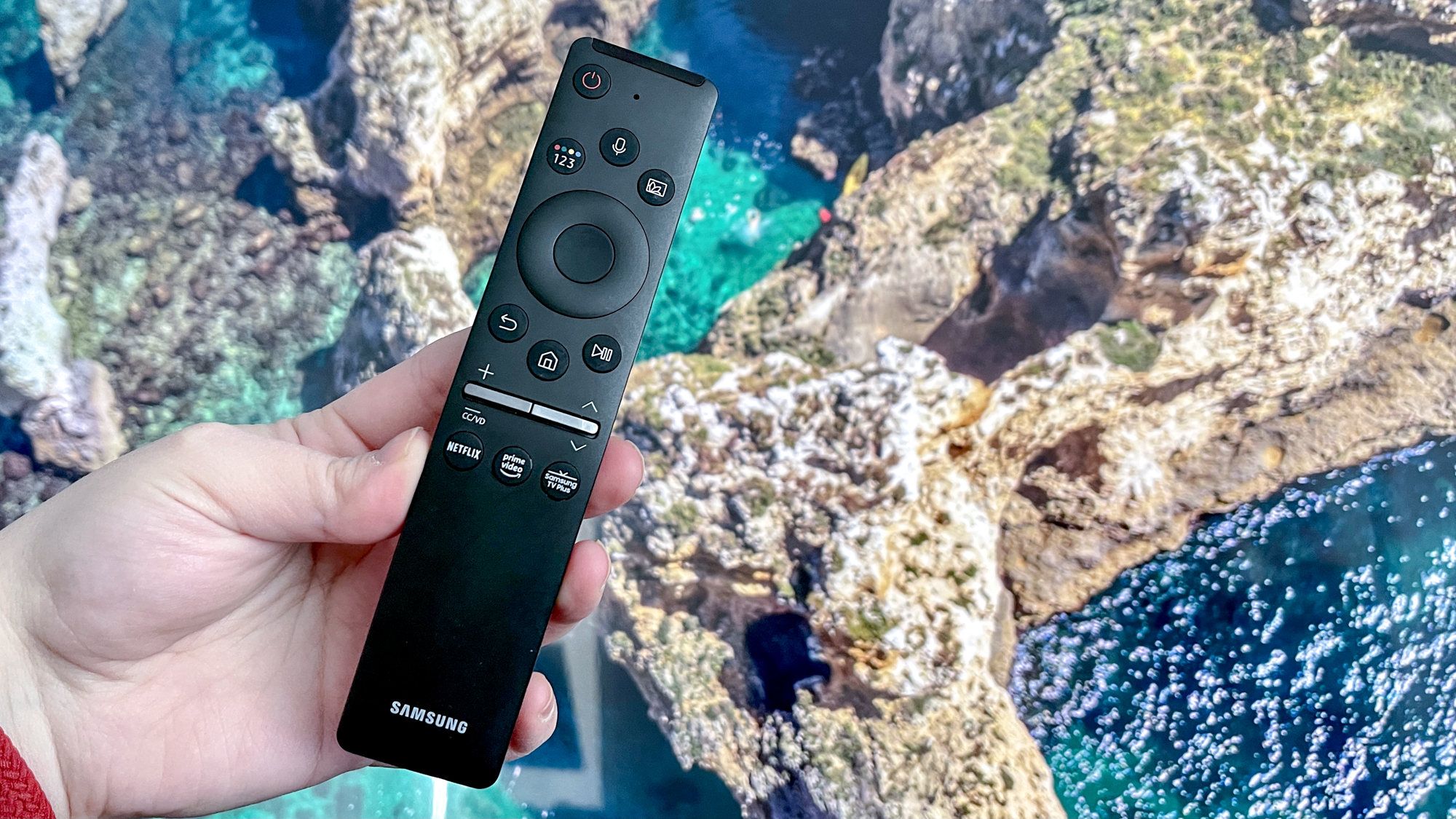
This version of Samsung’s remote provides a shortcut to Ambient Mode, as well as dedicated launch buttons for Netflix, Prime Video and Samsung TV Plus. For anyone who uses these services regularly, you can’t beat the convenience.
Samsung Q80T QLED TV review: Verdict
Samsung seems to have found its stride in QLED. In the past the company’s technology couldn’t keep up with LG and Sony OLEDs, but that’s no longer the case. In fact, after wrapping up this Samsung Q80T QLED 4K TV review, I could make the case for purchasing a QLED instead of our overall favorite TV right now, the LG CX OLED. It has LG’s set beat in tested brightness and comes in about $200 to $300 less for the 55-inch model, depending on current sales.
But is the Samsung Q80T QLED 4K TV the one to get? If you can spare the extra cash, the Q90T’s upgrades (namely the One Connect box) are worthwhile. That is, unless you’re eyeing a sexy 85-inch screen. The price difference between the Q90T and Q80T in the largest configuration is thousands of dollars, not hundreds. As for the cheaper Q70T, and Q60T sets, you’ll lose the full array backlight and local dimming — compromises that strike a big enough blow to QLED quality to discount these models from our recommendations. If you don’t mind looking outside of Samsung for a comparable alternative at a lower cost, the TCL 6-Series is a better option.
Although the Samsung Q80T QLED 4K TV’s test results are a mixed bag compared to those lower-tier models, the average viewer won’t pick up on the shortfalls. Sure, cinephiles would probably appreciate a set with stronger accuracy, while gamers should look for something with shorter lag time; however, for the price, brightness, upscaling capabilities, sound and smart features, I’d put the Q80T on your short list.
Kate Kozuch is the managing editor of social and video at Tom’s Guide. She writes about smartwatches, TVs, audio devices, and some cooking appliances, too. Kate appears on Fox News to talk tech trends and runs the Tom's Guide TikTok account, which you should be following if you don't already. When she’s not filming tech videos, you can find her taking up a new sport, mastering the NYT Crossword or channeling her inner celebrity chef.
-
Leon Odell In your review you state that there is no HDMI 2.1,Reply
This is only true of the 49" version, the 55" and bigger all have 1 of the 4 HDMI ports at 2.1 standard -
QSPR Reply
Hello there, a new suscriber here just to clarify that the Q80T have 1 HDMI 2.1 (HDMI port 4) and can produce image 4K @ 120hz!admin said:The Samsung Q80T QLED TV combines clever smart features, a powerful Quantum processor and impressive Object Tracking Sound to create one of the most formidable Samsung sets yet.
Samsung Q80T QLED TV review: An amazing OLED alternative : Read more -
Leadspectre87 I have the Samsung Q80T 55" TV and can confirm it has 1 HDMI 2.1 port being port #4 with a gamepad icon and my Xbox Series X plays fine at 4K@120hz with VRR, please rectify on review as not to mislead. Thanks.Reply
That's right please make this clear on reviewQSPR said:Hello there, a new suscriber here just to clarify that the Q80T have 1 HDMI 2.1 (HDMI port 4) and can produce image 4K @ 120hz!
Exactly right needs to be corrected on reviewLeon Odell said:In your review you state that there is no HDMI 2.1,
This is only true of the 49" version, the 55" and bigger all have 1 of the 4 HDMI ports at 2.1 standard
